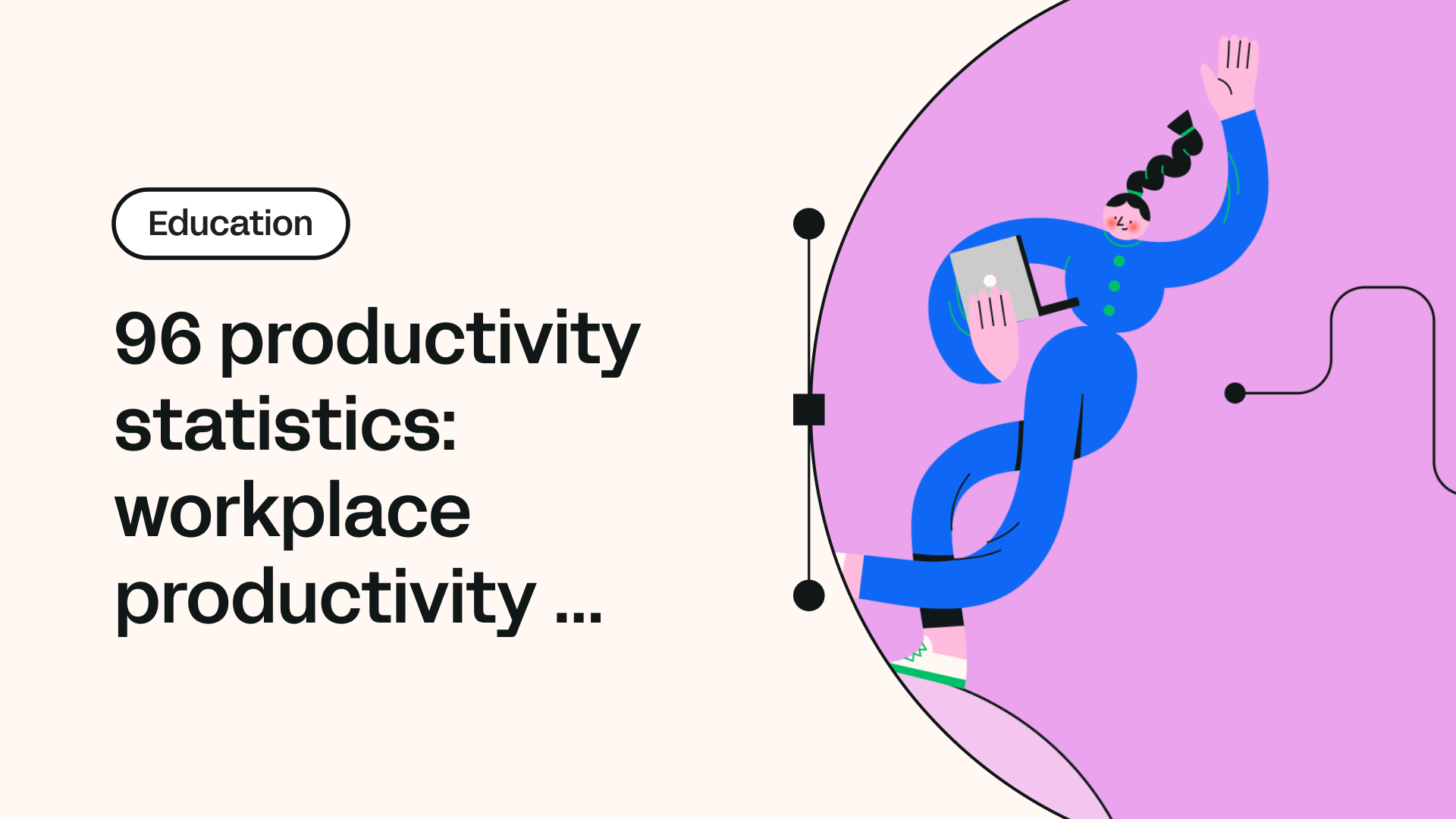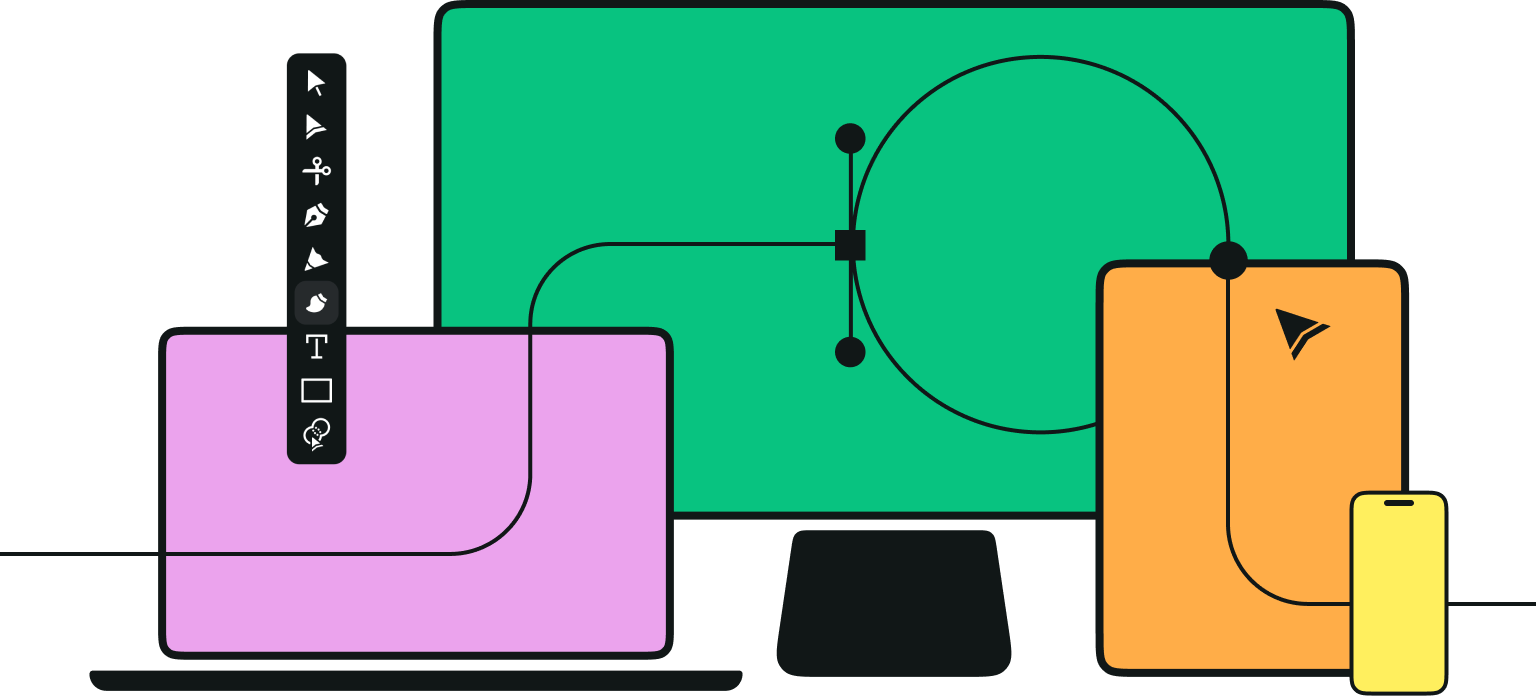Productivity means how much you can produce with what you have. It looks at how well you use your resources, like time and money, to make goods or services. Being productive is important for your company’s growth and its ability to compete with others. This is why comparing productivity levels between companies helps in understanding how well a company is doing.
The way we work is always changing, and knowing how to be productive is more important than ever. In this article, we’ll explore workplace productivity facts and figures to help individuals and teams meet their goals, no matter where or how they work.
Key trends in productivity
Almost half of medium-sized businesses saw a 10% increase in productivity after using workforce management tools.
Even a year and a half after employees’ training, they are 10% to 22% more engaged, and the team engagement increases by 8% to 18%.
People working from home have 10% fewer meetings than those in the office, allowing them more continuous work time and increasing their efficiency.
Creating a work environment where employees can pick where they work has led to a 17% boost in how much work they get done.
When employees are engaged, 43% are still looking or open to new job opportunities. However, when employees are disengaged, this number increases to 61%.
What this means: Using the right tools and training can significantly improve productivity and engagement at work. By adopting workforce management tools, allowing employees to choose their work environment, and reducing meetings for remote workers, businesses can see a notable increase in efficiency. However, it's important to keep employees engaged, as even those who are involved might still consider other job opportunities, and disengagement can drive this number even higher.
We've ensured this information is accurate and useful for anyone looking to improve their work habits or daily routines. Using the latest data, we discuss what influences productivity and offer straightforward advice for making positive changes.
Workplace productivity statistics
Workplace productivity is about measuring how much work gets done. I learnt what helps me work better through numbers and charts, are things like changing meeting times or taking more breaks. This helps make work better for everyone.
- In 2023, US workers spent about 7 hours and 24 minutes each day looking at their screens.1
- In 2023, employees in the US finished their tasks 2 minutes faster due to small changes in how they divided their time between focusing, working together, and handling multiple tasks at once.1
- In the first six months of 2023, people were slightly more productive, gaining about 4 extra minutes each day, than in the last six months of the year.1
- In 2023, the first quarter saw the highest productivity and focus, with 7 hours and 1 minute of effective work and 4 hours and 47 minutes of concentration. The fourth quarter had the lowest productivity at 6 hours and 50 minutes, and the third quarter had the least focus at 4 hours and 36 minutes.1
- Tuesday was the busiest day, working nearly 7 hours, while Friday saw the least work with just under 6 hours and 45 minutes. Mondays had the most dedicated work time at almost 4 hours and 45 minutes, but Fridays were the least focused, with about 4 hours and 35 minutes in 2023.1
- There was an increase in productivity potential with just an extra 5 minutes of focused work each day, over a typical 5-day work week that averages 7.4 hours per day in 2023.1
- In 2023, employees used 20% more tools, websites, and apps.1
- The amount of time people spent using different types of tools changed from one year to the next. This suggests that people might focus more on certain tasks or change how they work. Here are the shifts in four categories:
- Design tools increased by 18%. 1
- Admin/IT tools increased by 13%.1
- Developer tools increased by 9%.1
- System Processes tools increased by 5% in 2023.1
9. In the first quarter of 2022, productivity went down by 7.3%, while the cost of labor per unit increased by 12.6%.7
10. 96% of talent experts agree that the way employees feel at work greatly impacts how productive they are.7
11. More than 38% of very dedicated workers are also very productive.7
12. Almost half of medium-sized businesses saw a 10% increase in productivity after using workforce management tools.7
13. Productivity apps and tools for managing tasks have helped people finish their work 28% faster.7
14. When managers regularly acknowledge and praise their employees, productivity goes up by 23%.7
15. Creating a work environment where employees can pick where they work has led to a 17% boost in how much work they get done.7
Small changes at work can make a big difference in productivity. Using productivity apps and adjusting meeting times are examples. But it's also clear that creating a positive work environment and recognizing employees' efforts are important.
As I keep improving, it's important for me to remember that behind the numbers are real people doing their best at work.
Employee engagement statistics
Think of a place where everyone is happy to work. It's not just luck. Leaders learn from facts and figures to make workplaces where people love to be. Numbers can reveal how to make jobs better so everyone feels they're valuable contributors.
- Even though only a small number of employees (5%) worked on weekends, they spent more time working on those days, with an increase of 18 minutes in 2023.1
- Computer hardware employees worked 11.5 hours on average during weekends, a 31% increase, while media industry companies worked 10.7 hours, marking a 53% increase. Both industries did about 4 hours more weekend work than any other industry in 2023.1
- In 2022, 23% of workers worldwide were really engaged at work. A big part of this increase happened because people in South Asia, especially in India, became 7% more involved in their work. India is expected to be the most populous country in the world this year.3
- In 2023, South Asia had the highest level of involved and enthusiastic workers globally, with a rate of 33%.3
- Most people working around the world are not fully engaged in their jobs. Here's a breakdown:
- 23% are highly engaged and thriving in their work.3
- 59% are not fully engaged, often doing just enough to get by, which is commonly referred to as "quiet quitting."3
6. 18% are very disengaged and may openly express their dissatisfaction, a situation sometimes called "loud quitting."3
Quiet quitting: These workers are just there to fill a spot and watch the time pass. They do the least they have to, feeling no real connection to their job or company. They might get some things done, but they're more stressed and burned out than their more involved colleagues because they don't feel a part of their workplace.
Loud quitting: Workers in this category do things that hurt the company, going against its aims and leaders. Something big went wrong with their trust in the company, or they've been put in a job that just doesn't fit them, leading to constant problems.
7. A Gallup study found that engaged employees need a 31% raise to think about joining a different company, while disengaged or very unhappy employees might switch jobs for a 22% increase in pay.3
8. When employees are engaged, 43% are still looking or open to new job opportunities. But when employees are disengaged, this number increases to 61%.3
9. Even a year and a half after employees’ training, they’re 10% to 22% more engaged, and team engagement increases by 8% to 18%.3
10. After people finished Gallup's training program, and for up to 18 months later, they kept seeing improvements:
- Employees who completed the program were 10% to 22% more engaged at work.3
- Their teams felt 8% to 18% more engaged.3
- Fewer employees left their jobs, with a drop of 21% to 28% in turnover.3
- There was a 20% to 28% greater chance of achieving high performance.3
11. 91% of people who use productivity technology are actively engaged.5
Engaged employees, for instance, demand substantial raises to leave, indicating that professional development and access to efficient tech lead to greater contentment and retention. Improving workplace satisfaction involves identifying and addressing employees' needs with appropriate support and resources.
12. Only 24% of people without productivity-boosting technology are engaged.5
13. About 58% of people working remotely feel engaged with their job, either a lot or a little. Only 12% feel ‘neither here nor there’ about their job, and 30% feel somewhat or very disengaged from their work.6
14. Having dogs around boosts worker productivity by 30% and improves how engaged they are with their work by about 14%.7
15. Only 21% of workers in the UK say they stay productive all day long.7
16. Employees who are involved and committed perform better than those who aren't. Companies with highly engaged employees make 21% more profit on average.8
17. More than 38% of workers who are actively involved in their work also get more done.7
18. Engaged employees show a notable 21% boost in how much work they get done.7
19. Employees who aren't fully engaged can cost companies $450 to $550 billion each year.7
20. When an employee isn't fully engaged, the company can lose about 34% of that person's pay because they don't work as efficiently.7
21. Companies with disengaged employees see a drop of 18% in how much they get done and a 16% decrease in how much money the company makes.7
True workplace happiness comes from feeling connected and knowing your work matters. It's not just about the hours you put in or the tools you use. Even when work gets tough, like on weekends, feeling part of a bigger mission makes it all worthwhile. The real secret to a great workplace is making everyone feel important and part of a team. This approach goes beyond the status quo, leading to happier people and stronger companies.
Remote work productivity statistics
Remote work means different setups for different people. We look at stats to understand our work habits, best times for productivity, and small tweaks that improve our day. It's about figuring out how to work well, whether from home, a café, or any place else.
- Around 55% of young adults aged 18 to 34 who could work entirely from home reported that mental health problems affected their work performance. In contrast, only 17% of those aged 55 to 64 felt the same way.2
- Employees with kids at home, given the choice to work from home full-time, often said health issues or a bad workplace affected their job more than those without kids did.2
- Both young and remote workers in East Asia experience very high daily stress, with 60% and 61% of them feeling this way, making them the most stressed workers globally.3
- 22% of people said the top advantage of remote work is being able to manage their time freely. For 19%, it's the ability to live wherever they want, and for 13%, it's choosing their workplace.6
- A third of people working from home say their main issue is that they don't go out much because they don't have a reason to. The second biggest problem is feeling lonely, which affects 23% of remote workers.6
- 81% of people working from home say they read work emails when they're not working. This includes 63% who check work emails on weekends and 34% who do so even on vacation.6
- Almost half of remote workers worldwide (48%) frequently work outside standard business hours, and nearly the same number say they worked more in 2023 than they did the year before.6
- 22% of people say their biggest problem with working remotely is not being able to disconnect.6
- Nearly half of the people working from home in 2022 said they felt more energized (48%), while about a fifth felt overwhelmed and exhausted (21%).6
- Likewise, 58% of people working from home feel involved and interested in their jobs, while 30% don’t share the same level of interest.6
11. 62% of people working from home like to use their cameras during video calls. When asked, 67% of people said they find it easier to communicate when they can see the other person's facial expressions.6
12. Video calls are the main way remote teams meet. Buffer discovered that about 25% of remote workers must use their camera during calls. Around 33% said it varies, and 34% have no rules from their company or clients about using the camera.6
13. Another 3% mentioned that their job doesn't involve video calls, while 5% said they have to keep their camera turned off during these meetings.6
14. Other reasons people preferred video meetings were because they make them get ready for work (4%), help them feel less alone (16%), and avoid judgment for not showing their face (5%).6
15. For people who prefer meetings without video:
- 26% don't want to bother getting ready for the camera.6
- 22% like to move around instead of sitting still during calls.6
- 18% feel that being on camera is too draining, and 17% don't enjoy seeing themselves on the screen.6
- 15% are concerned others might think their surroundings look unprofessional.6
16. For half the people working remotely, messaging apps are the main way they collaborate. Emails come next, used by 22%, and meetings follow, preferred by 19%.6
17. Remote workers find that certain tasks are simpler to handle from home, particularly tasks requiring concentration (70%), managing stress (65%), and staying away from distractions (50%).6
18. Many think working from anywhere might mix up work and personal life. But almost half (45%) of remote workers find it easier to separate their work and personal life.6
19. Talking about separating work from personal life, 71% of people surveyed said it's very important, and another 22% think it's somewhat important, making up 93% altogether.6
20. Additionally, 78% of people working from home reported having a good balance between their work and personal life.6
Despite potential challenges in separating work and personal life, many remote workers report achieving a good balance, suggesting that remote work offers a new way to blend professional and personal life effectively.
21. People who work from home are generally 35–40% more productive than those who work in an office.7
22. Since before the pandemic, people working from home noticed they're getting about 22% more work done.7
23. Allowing employees to work from home or choose their own schedules increases their productivity by 17% because it lets them work in ways that best suit their needs and situations.7
24. About 83% of professionals think that going to the office isn't needed to get work done.7
25. 21% of remote workers spend an hour on their phones during work hours.7
26. People prefer to work from home mainly because it helps them balance their personal and work lives better, leading to increased productivity.7
27. People working from home are over half as likely to take a day off than those who work in an office.7
28. One out of three people working from home would be happier if their jobs checked how well they work. But 43% of them would be upset and think about quitting if their companies started watching them.7
29. During the pandemic, a study showed that 63% of workers felt they got more done at home because there were fewer distractions and they could concentrate better on their work.7
30. Studies suggest that people who work from home are 25% less likely to call in sick compared to those who work in an office. This indicates they might be healthier and miss fewer days of work, leading to better performance.7
31. People working from home have 10% fewer meetings than those in the office, allowing them more continuous work time and increasing their efficiency.7
Remote work is changing how we work and live, tailored to our personal needs. Whether it's young adults, parents, or people from different parts of the world, everyone is finding their own way to be productive and healthy. The shift towards video calls, messaging apps, and flexible work hours shows our effort to stay connected and work efficiently from anywhere. Remote work is about finding better ways to fit work into our daily lives.
Employee satisfaction statistics
In some workplaces, people are delighted to go to work. They feel valued and supported. The numbers show that happy employees do a better job. It's as simple as that: happy people work better.
- In 2022, almost all regions—especially Southeast Asia, Australia, and New Zealand—saw at least a 10% increase in workers feeling optimistic about job hunting, with some areas experiencing a 22% rise.3
- In 2022, unlike other places, the US and Canada didn't see more people enjoying job hunting. But the year before, there was an increase of 44% in that belief.3
- In 2022, over half of employed people were either looking for a new job or keeping an eye out for opportunities.3
- Seven out of ten top executives are thinking about leaving their jobs to find ones that take better care of their health and happiness.4
- Only 55% of people think the technology at their current job is better than what they've seen at previous jobs.5
- Having a good balance between work and personal time helps you do better at your job and feel happier.9
- Happy employees reportedly work 31% better and sell 37% more.9
- When people see how their work fits with the company's goals and principles, they feel satisfied and work better.9
- Companies focused on a clear mission gained more market share and grew three times faster than their rivals.9
Absolutely spot on! Employee satisfaction extends way beyond just the paycheck. Embracing lifelong learning, prioritizing well-being, valuing diversity, and fostering a sense of purpose all play crucial roles. I've always believed that when leaders lead with authenticity, it creates an environment of trust and mutual respect. These factors combined drive not only satisfaction but also unparalleled productivity and growth. Kudos for highlighting these pivotal aspects! - Marko Ladis, CEO at BinLab on LinkedIn
The way an office looks and feels plays a significant role in how happy and productive workers are. Good office design can make people do better work, more of it, and in their own way. It can also help keep people from leaving their jobs and taking too many days off.
10. Getting natural light and seeing outdoor views can make people feel happier and more satisfied with their life (78%), enjoy their work more (73%), perform better at their jobs (70%), and feel more connected to their organization (54%).11
11. When noises and distractions are reduced or eliminated, employees feel 25% happier with their work setting and 27% less stressed. Overall, they can become about 20% more productive.10
12. Natural elements in workspaces make people 15% happier, 6% more productive, and 15% more creative, leading to increased job satisfaction and productivity.10
Happy employees are critical to a successful workplace. The evidence shows that satisfied workers are more productive and creative. The focus should be on creating a positive work environment where everyone feels valued and supported. Good leadership and a strong connection to the work's purpose are essential. The goal is to make workplaces where people are productive and feel fulfilled.
Factors affecting employee productivity
Employees need certain things to work well, such as the right workload and good support from their team. These statistics help us see what propels or slows them down.
- The number of employees working too much fell by 8%, and the number not working enough stayed the same.1
- In 2023, 28% of employees are still in danger of feeling burnt out, becoming less interested in their work, and possibly leaving their jobs.1
- In 2023, about 12% of workers were extremely busy for most of the year (over three-quarters of their time).1
- From February to December, the use of healthy options increased by 6% in 2023.1
- Engagement affects employee stress nearly four times more than where they work.3
- 76% of top executives believe the pandemic has hurt their well-being. Also, less than two-thirds of workers consider their health to be "excellent" or "good" in different areas.4
- In 2022, job stability was a major issue. About 30% of people surveyed said they were afraid they might lose their job within a year, while the rest, about 70%, weren't worried about it.6
- Trying to do many things at once can cut your efficiency by almost half.7
- In the US, about 600,000 workers spend 90 minutes commuting every day, which affects how much they can get done at their workplace.7
- 41% of employees say stress makes them less productive.7
- Emails, social media, and texting are responsible for 60% of distractions at work.7
| Time spent worrying about stressors | How much time employees allocate to them (%) |
|---|---|
| Less than 1 hour a week | 28% |
| 1-5 hours | 50% |
| 5-10 hours | 16% |
| More than 10 hours | 6% |
12. Starting wellness programs like mental health support and stress management can boost productivity by 23% because they help employees handle job challenges better.7
13. Over 70% of workers feel they get more done when they listen to music at work, especially if it's pop, rock, or country music.12
14. Focusing on the goal and meaningful work can make people 16% more productive by inspiring them to work together towards important achievements.7
15. Younger workers between 18 and 34 enjoy listening to music at work the most, with 95% saying so. This is higher than the 84% of workers aged 35 to 54 and the 66% of those 55 and older who feel the same.12
"While music can be a stress reliever or source of motivation for many workers, it can be a distraction for others. Those who want to listen to music in the office need to be aware of company policies and considerate toward their colleagues," says Michael Steinitz, Senior Executive Director at Robert Half.
Balancing workloads and offering personal touches like wellness programs and music at work can make a big difference in keeping employees happy and productive. Even though we're seeing less overload, a quarter of employees still risk burnout. This suggests that companies need to keep looking for ways to better support their teams, focusing not just on the work but also on what makes employees feel good and work well together.
Frequently asked questions
What’s the 70 percent rule for productivity?
The 70 percent rule, in a business context, is a time management principle suggesting that people should withhold a significant amount of their working capacity for better productivity, engagement, and work-life balance.
How do I overcome procrastination?
Overcoming procrastination involves understanding the root cause. Strategies include breaking tasks into smaller, manageable parts, setting clear deadlines, using positive reinforcement, and minimizing distractions.
Techniques like the Pomodoro Technique, where work is broken into short intervals (traditionally 25 minutes), followed by a short break, can also help maintain focus and momentum.
What are the best time management techniques?
Effective time management techniques vary by individual preference and work style, but some universally recognized methods include:
- Prioritizing tasks using tools like the Eisenhower Matrix, which separates tasks into four quadrants based on urgency and importance.
- Setting specific goals using the SMART criteria (Specific, Measurable, Achievable, Relevant, Time-bound).
- Time blocking, where you allocate specific blocks of time to tasks or groups of tasks.
- Batch processing, grouping similar tasks together to minimize switching costs between different types of activities.
How can I stay motivated?
Staying motivated can be challenging, especially with long-term goals. Key strategies include setting clear, achievable goals, finding personal significance in the tasks, maintaining a positive mindset, and rewarding progress.
Regularly reviewing and adjusting your goals to reflect your current situation and aspirations can also keep motivation high.
What tools can help increase productivity?
Numerous tools can aid productivity, from simple to-do lists and calendars to complex project management software. Popular choices include:
- Task management apps like Todoist, Trello, or Asana for organizing and tracking tasks.
- Time tracking tools like RescueTime or Toggl to analyze how you spend your time and identify areas for improvement.
- Note-taking apps like Evernote or OneNote for organizing thoughts, ideas, and information.
- Focus apps like Forest or Freedom to help minimize distractions from your phone or the internet.
Sources
- Activtrak Report
- McKinsey
- Gallup Report
- Deloitte
- Qualtrics Report
- Buffer Report
- MarketSplash
- Haiilo
- Entrepreneur
- PR News Wire


Share this!


:quality(75))
:quality(75))



:quality(75))




